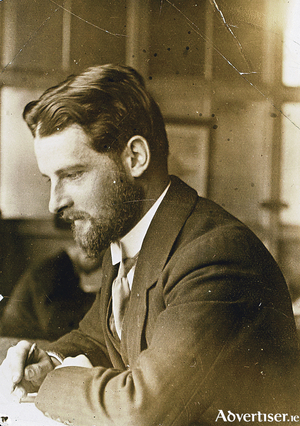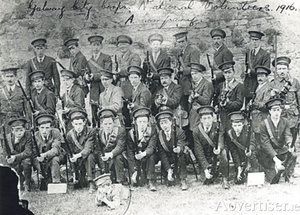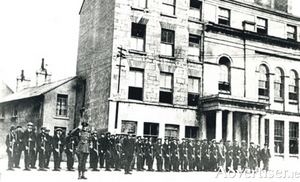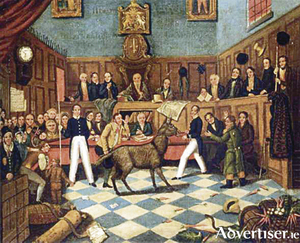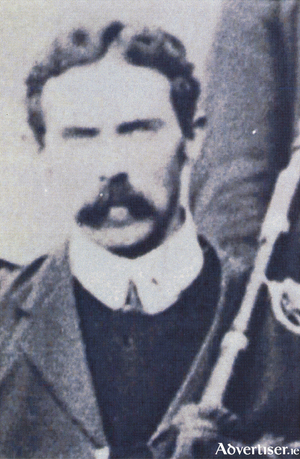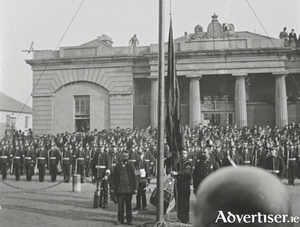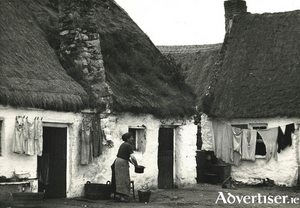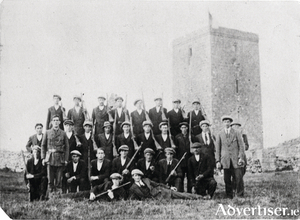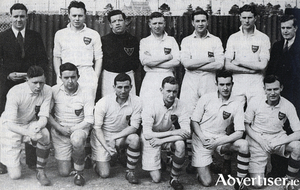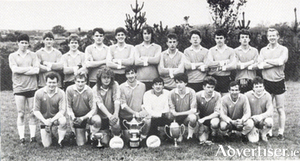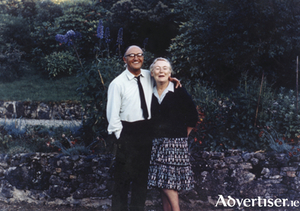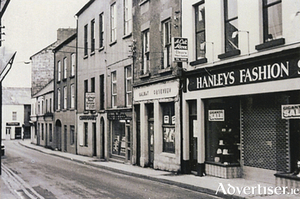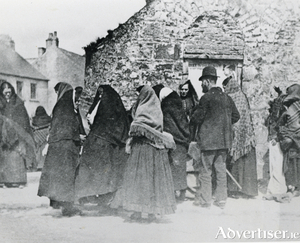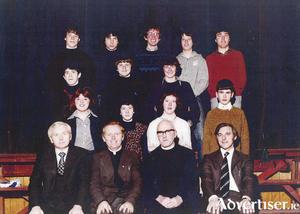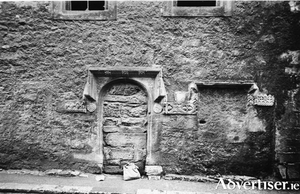George Nicolls, c1887-1942
Thu, Mar 31, 2016
George Nicolls (Seoirse Mac Niocall) was born in Dublin but his professional career brought him to Galway town, where he worked as a solicitor and coroner for the West Riding District of the county. A committed nationalist, he became involved with Sinn Féin in 1907 and also served as president of the county board of the GAA. Nicolls was the IRB Centre for Galway town. On November 31 1913, he presided over a meeting in the Town Hall, for the purpose of formally establishing the Irish Volunteers in the county, and subsequently chaired the ‘monster public meeting’ in the Town Hall on December 10, at which 600 individuals signed up for the Volunteers. Nicolls also established a pipe band (Cumann Píobairí na Gaillimhe), where all but three were IRB members. It toured the county, playing at events such as GAA matches and concerts, which provided opportunities to recruit new members.
Read more ...The Galway Volunteers
Thu, Mar 24, 2016
Just a few weeks after the Irish Volunteers were formed in Dublin, a meeting was set up in the Town Hall on December 12th, 1913 to establish a Volunteer force in Galway. There was a lot of excitement and expectation as Eoin McNeill, Roger Casement and Pádraic Pearse told the packed hall that their main objective was to win Home Rule but the movement was also formed to protect them from the Ulster Volunteers. The meeting, which was chaired by George Nicholls, was a major success and some 600 men joined up that evening.
Read more ...St Patrick’s Day parade in Galway, 1916
Wed, Mar 16, 2016
This parade started from the Square in the following order: Eyre Square North – Industrial School Band; Galway Urban District Council; Galway Board of Guardians; Students of UCG; AOH. Eyre Square East – The Monastery School Fife and Drum Band; UIL; Town Tenant’s League; Galway Woollen Manufacturing Co; and the Irish National Foresters.
Read more ...The Eglinton Canal
Thu, Mar 10, 2016
One hundred and sixty eight years ago this week, on March 8, work started on the cutting of what we know as the Eglinton Canal. There had been previous attempts to open a passage from the river to the sea. As far back as 1498, the then mayor had a plan to connect the Sandy River with Lough Athalia. It was Alexander Nimmo who first mooted the idea of a canal in 1822. If steamboats could travel from the docks to the Corrib, it would greatly enhance the commercial importance of the city and a valuable connection with the hinterland would be established. His original plan was that this connection would start at the top of Woodquay, where McSwiggan’s is today, go along Eglinton Street and down the west side of Eyre Square to the docks. The cost proved to be prohibitive and there were a lot of objections from people who owned land or a business along the route.
The actual construction of the canal, as we know it today, provided much needed work and relief during the Famine. The filling they dug out was used to fill terraces in UCG and also to fill in the causeway behind Claddagh Quay. The Claddagh Basin was constructed to cater for the 300 boats which were operating out of the fishing village at the time. Canal locks were constructed at the Basin and at Parkaveara, and the project included five swivel bridges.
Read more ...Republican prisoners in the Town Hall
Thu, Mar 03, 2016
This remarkable photograph was taken in 1920/21. It shows a group of republican prisoners who are being held in the Town Hall. They are surrounded by barbed wire and are being carefully watched by a soldier you can see standing beside the tin hut. He is wearing a ‘Brodie’ helmet which was a steel combat helmet invented by Englishman John Brodie during World War I. There were probably more soldiers on duty inside the hut watching the detainees, the photographer, and anyone else who might have been was passing. A notice on one of the windows reads “No one is allowed within ten yards of this building.”
Read more ...Nineteenth century Galway elections
Thu, Feb 25, 2016
Elections in the 19th century were a great deal more lively, entertaining, and violent than those of the present day.
Read more ...Dick Martin’s desperate struggle to retain his Galway seat
Thu, Feb 25, 2016
The present national election is a mild and gentle affair, compared to some previous occasions though none reached the madness and abandonment of the notorious Galway election of 1826.
Read more ...Seamus Carter, athlete, Gaeilgóir, patriot
Thu, Feb 18, 2016
Seamus Carter was a fluent Irish speaker who was a member of the Gaelic League since its inception. He was the secretary of the Oireachtas when it was held in Galway in 1913, the famous photograph of which hangs in the Town Hall.
Read more ...The Proclamation Of King George V
Thu, Feb 11, 2016
“The accession of His Majesty King George V was proclaimed in Galway at 2 o’clock on Saturday (21st of May, 1910). The ceremony was performed by the High Sherriff, Mr. Cecil R. Henry, and took place opposite the Courthouse. On the steps of the building there was a fashionable gathering. Outside the hollow square formed by soldiers and police, the crowd was one of immense proportions. About one hundred men of the Connaught Rangers, with their band and the King’s colour, under Major Sarsfield, were formed up in line opposite the Courthouse, and an equal number of the Royal Irish Constabulary, drawn from Galway and outside stations, filled up the remaining sides of the square. They were in charge of Co. Inspector Flower, Districts-Inspectors Mercer and O’Rorke.
Read more ...Wash day in The Claddagh
Thu, Feb 04, 2016
“With its old houses — straw for their roofs and rock and mortar for their walls, and every little end of a wall whitewashed a hundred times in blue or white or thin pink — the Claddagh was lovely, and from a distance it did the eye good. It was quaint, of course, but also a home-like little village; it had sand for its walks and a turfy marlish stuff for its floors, and always curls of smoke from its square low chimneys.
Read more ...The First Galway Brigade, 2nd Battalion
Thu, Jan 28, 2016
During the War of Independence, the Volunteers, for organisational purposes, divided the country into divisions. Connacht and County Clare were split into four such sections. In each of these, the members were divided into brigades, battalions, companies, and flying columns. The First Galway Brigade was divided into three battalions, Castlegar, Claregalway, and Headford.
Read more ...GALWAY c1200 to c1900
Fri, Jan 22, 2016
The above is the title of a newly published folding map by the Royal Irish Academy. It has been compiled by Jacinta Prunty and Paul Walsh using the extensive topographical information which they collected while working on a forthcoming book entitled Galway in the Historic Towns Atlas series. They also studied old maps of the city. This map extends from Newcastle Road to College Road and from Terryland to Nimmo’s Pier. The map and its extensive indices are unrivalled in their detail and afford a unique window into the earlier medieval topography and way of life in the city.
The heavy black line represents the old walls of Galway superimposed on a current ordinance map of the city centre. The various symbols we see are all described on the index to the map and also dated. So, for example E30 is listed as a ‘Meal and Flour Mill, 1656’.
Read more ...FAI Junior Cup finalists 1941
Thu, Jan 14, 2016
John O’Dowd was a Galway born printer who went to work in Kilkenny and became involved with the formation of a junior soccer league in the area. In 1931, his widowed sister, Mrs Brigid Mulryan from Woodquay, died and left four children. John gave up his Kilkenny job and returned to Galway to mind the children. He worked for a while in the Connacht Tribune and later in the Galway Printing Company.
Read more ...West Board Junior Champions 1989
Fri, Jan 08, 2016
Barna had a hurling team in 1964 and handball was very popular in the area, but anyone wanting to play football would have togged out for An Spidéal. Local games were played in Sean Lydon’s field along the shorefront, halfway between the church and Barna school. Kevin Curran and Nicholas O’Fegan were the founders of Barna GAA Club in 1965 and they managed to field minor and junior teams that year. Their junior team had the honour of playing the club’s first competitive match on May 30 1965 against a Bohermore selection known as John F Kennedy’s. Kennedy’s won by a point.
Read more ...'Pat The Boat' a poem by Walter Macken
Wed, Dec 30, 2015
As we come to the end of the Walter Macken centenary, we thought it appropriate to reprint the only known piece of poetry that he wrote. It was first printed in 1963 in Criterion, a UCG magazine that was edited by Kevin Brophy at the time. It is homage, ómós if you like, to an old fisherman and reflects Macken’s love of fishing, of the Corrib, and of his understanding of people. The photograph of himself and his wife Peggy was taken in the garden of their home Gort na Gainiv near Oughterard c1960.
Read more ...George Nicholls, Rising organiser and volunteer
Thu, Dec 17, 2015
George Nicholls was a young solicitor who worked in G.C. Conroy’s office in Francis Street. In 1912, he set up a pipe band known as “Cumann Píobairí naGaillimhe”, the only band with an Irish language name to play at O’Donovan Rossa’s funeral to which they travelled in the company of Padraic Pearse.
Our photograph was taken that year. Nicholls was the nerve centre for the IRB in Galway. He later became the town coroner. In December 1913 he was involved in setting up a large public meeting in the Town Hall for the purpose of starting the Volunteers in Galway. Mairtín Mór McDonogh was in the chair and the speakers were Roger Casement and Eoin McNeill.
Read more ...Upper Abbeygate Street c1978
Thu, Dec 10, 2015
An old Galwegian gave us this photograph of Upper Abbeygate Street as seen from the corner of Market Street. In the late 1940s the building we see down at the end on the corner of Mary Street was Tommy Hopkins, victuallers. Opposite that, at the time, at the end of Abbeygate Street was Mrs Kemple’s house. Next door was Paul Heaney’s butcher shop; Moloney’s sweet shop; Barrett’s, Mrs Barrett had a cake making business; the Shapiros lived next door, and beside their house was an archway that led in to the back of the house; Ellie Carter and her brother were next; then Miko Cunningham’s sweet shop where he sold groceries as well. The next building was known as Carter’s Halls and among those who lived there were Mick Tuite, who was known only as ‘Shoots’, the Haynes family, Mary Anne O’Toole, Michael Melia, Chrissie Melia, Rose Anne Melia (these were Mary Anne’s children), Anthony Morris, Julia Murphy, Lizzie Hehir, Martin Cunniss, and Molly Hosty and her daughter.
Read more ...The egg and butter market in Woodquay
Thu, Dec 03, 2015
This photograph was taken about the year 1900 and shows part of the market at the corner of Woodquay and Eyre Street. The derelict gable we see in the background was later developed as Creaven’s boot shop. It was subsequently occupied by O’Connor TV, then became a florists run by Brian O’Malley, and today is Richard Hughes’ opticians.
Read more ...The first co-ed class in the Jes
Thu, Nov 26, 2015
St Ignatius College’ on Sea Road opened its doors for the first time in 1862. The Jesuits built a residence and a church at the same time and the move proved to be a success for them. Attendances at Mass and ceremonies grew rapidly. The college, however, was more of a challenge. The boys ranged in age from nine to 13 and the subjects taught included mathematics, Latin, Greek, and elocution. The numbers at first were as expected. They grew steadily to 90 in 1865 and reached 110 by 1874, but they began to fall thereafter and were inconsistent from year to year. The number recorded for 1899 was 49.
Read more ...The Athy Doorway
Thu, Nov 19, 2015
The Athy family are of great antiquity in Galway. They were originally Anglo-Norman, but on coming here, they quickly became one of the original Tribes. Their estates were mainly in the Oranmore area, they owned the Rinville Estate. They are credited with being the first family to erect a stone building in the city in the 13th century. Castles associated with the family through the years are Ballylee, Carrigín, Glinsk, Castletown, Rinville, Claregalway, Ardmullivan, De Bermingham’s, Aughnanure, and Castledaly.
Read more ...